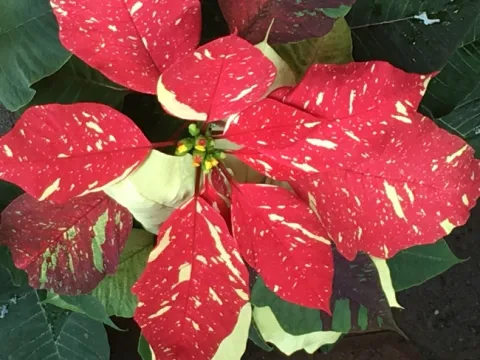
Poinsettia
By Leslie E. Stevens UCCE Master Gardener
Poinsettia (Euphorbia pulcherrima)
Planting Areas: Sunset Zones 13, 16-24 or indoors. Poinsettias prefer temperatures above 60 degrees but can survive lows to 50 degrees.
Size: Most poinsettias are grown as indoor potted plants. Outdoors they can grow into leggy shrubs 10 feet tall by 6 feet wide.
Exposure: Primarily grown in temperate areas, such as California's coastal zones.
Bloom Season: Poinsettias are considered winter bloomers. It is the plant's leaves, known as “bracts,” that acquire the striking colors for which the plant is known. More than 100 varieties are available today, including red, white, pink, burgundy, marbled and speckled.
Water Needs: Water potted plants about once/week when soil is nearly dry.
Little-Known Facts: Poinsettias are poisonous. Its milky sap can irritate skin and eating the leaves can cause nausea and vomiting. It's best to keep them away from pets.
Snapshot: The plant's brilliant color and winter bloom cycle make it the perfect holiday hostess gift or decoration. The top selling holiday flower in the United States is nearly as common as Christmas trees in December.
The Poinsettia is named after Joel Roberts Poinsett, the first U.S. Ambassador to Mexico, who discovered the plant in 1828 while visiting there. The plant hobbyist collected cuttings and then shared them with friends back in the U.S.
Hollywood farmer Paul Ecke recognized the Poinsettia's potential as a holiday flower and began growing the plant commercially. He established a distribution network, and in 1923 moved operations to Encinitas. It wasn't until the 1960s that his son, Paul Ecke Jr., developed a grafting technique that turned the spindly shrub into its current lush, compact form. By promoting Poinsettias on popular television shows such as the Tonight Show and Bob Hope Christmas specials, Ecke created today's iconic Christmas flower.
The Paul Ecke Ranch in California continues to produce over 70 percent of Poinsettias sold in the U.S. and accounts for about 50 percent of world-wide sales. The family-owned company was sold in 2013 and is currently part of German horticultural giant Dummen Orange.

